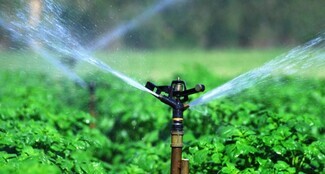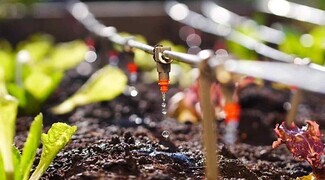IRRIGATION
MAINTENANCE
Leaks and Blockages: These are damaging for your irrigation system. If there is low pressure in some area, then leaks are bound to pop up. The sprinkler heads: Any damage to the sprinkler head can lead to inefficiency in the system. Check for any wear and tear on a periodic basis. Routine adjustments and regular maintenance checks are advisable.
UTILITY
Irrigation
APPLICATION
It allows release of water through a small diameter nozzle placed in the pipes. Water is distributed through a system of pipes, sprayed into air and irrigates in most of the soil type due to wide range of discharge capacity.
COST/UNIT (India)
Cost of installation is INR 30,000/ha (approx).
COST/UNIT (Bangladesh)
Starting from BDT 3500 (approx).
DURABILITY
Sprinkler irrigation is a very durable irrigation technique. If taken proper care, one can expect the system to last for an approximate 20 years.
ESTIMATED CAPACITY
The application rate depends on the size of sprinkler nozzles, the operating pressure and the distance between sprinklers. When selecting a sprinkler system it is important to make sure that the average application rate is less than the basic infiltration rate of the soil. In this way all the water applied will be readily absorbed by the soil.
SOCIO ECONOMIC BENEFIT
Water saving up to 30% - 50 %. Increases yield. Increases fertilizer use efficiency by crop. Marginal and irregular ground can also be irrigated. Reduced weed growth. Soluble fertilizer, herbicides and fungicides can be applied in the irrigation water economically and with little extra equipment. Reduces labour cost.
SUBSIDIES/ASSISTANCE FROM GOVT. (India)
35% of the total cost of installations for small & marginal farmers and 25% of actual cost of installation for others in non-DPAP/DDP/ NE&H regions. 50% of the actual cost of installations for small & marginal farmers and 35% of cost of installation for others in DPAP/DDP areas and NE & H States. Additional 10% assistance to be provided by State Govt. to all categories of farmers. < Drought Prone Areas Programmes (DPAP)>, < Desert Development Programme (DDP)>
SUBSIDIES/ASSISTANCE FROM GOVT. (Bangladesh)
N/A
AGENCIES INVOLVED (India)
Nodal Agency - Directorate of Agriculture/ Dept. of Agricultural Engineering (Uttarakhand & Assam) Implementation Agency - Office of Dy. Director/Joint Director/ Executive Engineer/ Assitant Engineer (Agriculture)
AGENCIES INVOLVED (Bangladesh)
Bangladesh Agri Research Institute (BARI), Bangladesh Agricultural university
MAINTENANCE
After starting the pump let the pressure be stabilized in the system. Inspect the dripping and ensure that water is reaching all the corners of the plot/field, if at some portion water is not dripping correctly find the cause & correct. Inspect uniform wetting pattern. If dry patches are found increase duration of operation.Monitor the mechanical damages (twist, fold, cut, puncher etc.) causing leakage; correct it immediately by using proper joiners.
UTILITY
Irrigation
APPLICATION
It delivers water to the crop using a network of mainlines, sub-mains and lateral lines with emission points spaced along their lengths. Each dripper/emitter supplies a measured, precisely controlled uniform application of water, nutrients, and other required growth substances directly into the root zone of the plant.
COST/UNIT (India)
(Wide spaced crops) - Estimated Cost of installation is INR 37200/ha (approx). (Close spaced crops with rows at less than 1.2 meter) - Estimated Cost of installation is INR 90,000/ha (approx).
COST/UNIT (Bangladesh)
BDt 67,000-84,000 per ha (approx.)
DURABILITY
Drip Irrigation system can last upto 12 to 15 years with proper maintenance.
ESTIMATED CAPACITY
Involves dripping water onto the soil at very low rates (2-20 litres/hour)
SOCIO ECONOMIC BENEFIT
Increase in yield up to 230 %. Saves water up to 70% compare to flood irrigation. Crop grows consistently, healthier and matures fast. Early maturity results in higher and faster returns on investment. Fertilizer use efficiency increases by 30%. Cost of fertilizers, inter-culturing and labour use gets reduced. Fertilizer and Chemical Treatment can be given through Micro Irrigation System itself. Undulating terrains, Saline, Water logged, Sandy & Hilly lands can also be brought under productive cultivation.
SUBSIDIES/ASSISTANCE FROM GOVT. (India)
35% of the total cost of installations for small & marginal farmers and 25% of actual cost of installation for others in non-DPAP/DDP/ NE&H regions. 50% of the actual cost of installations for small & marginal farmers and 35% of cost of installation for others in DPAP/DDP areas and NE & H States. Additional 10% assistance to be provided by State Govt. to all categories of farmers. (Drought Prone Areas Programmes (DPAP), Desert Development Programme (DDP))
SUBSIDIES/ASSISTANCE FROM GOVT. (Bangladesh)
N/A
AGENCIES INVOLVED (India)
Nodal Agency - Directorate of Agriculture/ Dept. of Agricultural Engineering (Uttarakhand & Assam) Implementation Agency - Office of Dy. Director/Joint Director/ Executive Engineer/ Assitant Engineer (Agriculture)
AGENCIES INVOLVED (Bangladesh)
Bangladesh Agri Research Institute (BARI), Bangladesh Agricultural university

